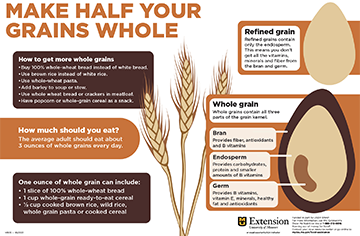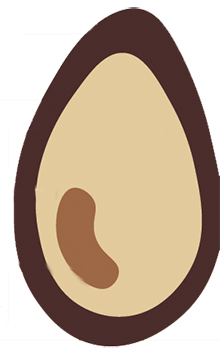Editor's note
The following abstract describes a publication that is available as a downloadable PDF.
See the companion publication N1006, Whole Grains Handout.

This poster reviews the benefits of eating whole grains, nutrients provided, how to get more and the benefits over refined grains.
Topics
- Nutrition
- Whole Grain
- Refined Grain
- Bran
- Endosperm
- Germ
- SNAP
Pages
- One 24 x 36 inches poster
See poster content below.
Make Half Your Grains Whole
How to get more whole grains
- Buy 100% whole-wheat bread instead of white bread.
- Use brown rice instead of white rice.
- Use whole-wheat pasta.
- Add barley to soup or stew.
- Use whole-wheat bread or crackers in meatloaf.
- Have popcorn or whole-grain cereal as a snack.
How much should you eat?
The average adult should eat about 3 ounces of whole grains every day.
One ounce of whole grain can include:
- 1 slice of 100% whole-wheat bread
- 1 cup whole-grain ready-to-eat cereal
- ½ cup cooked brown rice, wild rice, whole-grain pasta or cooked cereal
Refined grain
Refined grains contain only the endosperm. This means you don’t get all the vitamins, minerals and fiber from the bran and germ.

Whole grain
Whole grains contain all three parts of the grain kernel.
Bran
Provides fiber, antioxidants and B vitamins
Endosperm
Provides carbohydrates, protein and smaller amounts of B vitamins
Germ
Provides B vitamins, vitamin E, minerals, healthy fat and antioxidants
Funded in part by USDA SNAP.
For more information, call MU Extension’s Show Me Nutrition line at 1-888-515-0016.
Need help stretching your food dollars? Contact your local resource center or go online to mydss.mo.gov/food-assistance/food-stamp-program.